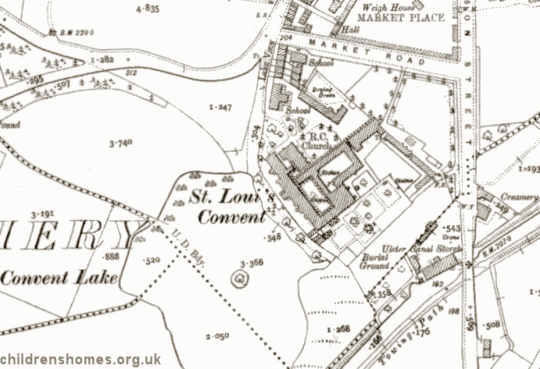St Martha's Industrial School for Roman Catholic Girls, Louisville, Co. Monaghan / Bundoran, Co. Donegal, Republic of Ireland
St Martha's Industrial School for Roman Catholic Girls was opened in 1869 by the St Louis Sisters. It was located at the southwest of Monaghan town, on a site known as Louisville which also contained the Sisters' convent, the Spark's Lake Reformatory, a young ladies' boarding school and a day school for paying pupils. The Industrial School was formally certified to begin operation on 4 November 1869 with accommodation for up to 67 girls. St Martha's was particularly used for the reception of girls suffering from scrofula, skin and other diseases, epileptics, and other conditions which could not be treated in other schools. It also received girls who were 'of filthy habits, ill-tempered and ill-conditioned'.
An inspection of the School in 1870 suggested that it was too close to the Reformatory and, given the particular nature of many of its inmates, should be removed to a seaside location. The girls were taught needlework, dress-making and shirt-making. Eight or ten of the strongest girls worked in the laundry for two days in the week, and some were employed in the dairy and farm-yard, others in baking bread and and cooking for the Sisters and for the ladies' school attached to the convent. Those with an aptitude for the work cared for the young and delicate placed under their charge. The Sisters joined with the children in all their recreations. The manager was Sister Genevieve Beale.
In 1874, extensive additions to the buildings were begun to provide increased dormitory and work-room accommodation for the inmates. An infirmary, separate from the main building, was also erected, together with large National schools. In 1876-7, a new building was erected containing a laundry, bathroom, drying-closets and a dormitory. The new laundry allowed washing to be done for the public. The girls cut out and made all the dresses used in the institution, as well as some for the shops. They were also taught knitting, crochet, lace-work, crewel and embroidery, and to make pastry, jellies, preserves and pickles. The girls milked cows, made butter, fed pigs and worked in the garden.
The Louisville site is shown on the early 1900s map below.

St Martha's Industrial School site, Monaghan, early 1900s.
In 1878, Sister Mary Angela Crotty became manager of the School. She was succeeded in 1880 by Sister M.X. Finnigan.
A new bakehouse was erected in 1881. The girls, without assistance, made and baked all the bread used in the establishment. Singing was taught to all the girls, and instrumental music to those intending to be teachers, as was also the case for freehand drawing and painting.
When the Spark's Lake Reformatory closed in 1903, its 21 inmates were transferred to the Limerick Reformatory for Girls. On 25 September 1903, the official capacity of St Martha's was increased by 21, taking it to 88 places.
An inspection report in 1911 recorded that the School's manager was Sister M. Farrell, who was assisted by seven Sisters of the Order of St Louis. The schoolrooms and dormitories were all heated by hot-water pipes and open fires, and the lavatories were of the most modern type. There were large playgrounds. Industrial training included cookery, laundry-work, housewifery, needlework, dairying and poultry care. The girls of the Third Standard, who constituted the 'family class', were allotted a fully equipped 'cottage', of which they had charge, under direction of a sister. There was also a School 'shop', which was managed by the girls in turn. A drill instructress attended the school weekly, and gave lessons in Swedish drill, dumb-bells, bar-bells, Indian clubs and musical drill. They also had dancing in the evenings.
In 1912, the Countess of Aberdeen visited the School to present it with the Challenge Shield, offered for competition amongst all the Industrial Schools in Ireland by Sir John Fegan. The trophy, competed for every three years, had also been won St Martha's in 1907. Dr Flynn, the government's head inspector of Industrial Schools, described St Martha's as the 'premier industrial school of Ireland'.
In 1958, the School moved to a new site at Bundoran, Co. Donegal, where 120 girls could be accommodated. It continued to operate there until its final closure in 1966.
Records
Note: many repositories impose a closure period of up to 100 years for records identifying individuals. Before travelling a long distance, always check that the records you want to consult will be available.
- None identfied at present — any information welcome.
Bibliography
- Arnold, Mavis, and Laskey, Heather Children of the Poor Clares (2004, Appletree Press)
- Barnes, Jane Irish Industrial Schools 1868-1908 (1989, Irish Academic Press)
- Dunne, Joe The Stolen Child: A Memoir (2003, Marion Books)
- Rafferty, Mary and O'Sullivan, Eoin Suffer the Little Children: The Inside Story of Ireland's Industrial Schools (1999, New Island Books)
- Touher, Patrick Fear of the Collar: Artane Industrial School — My Extraordinary Childhood (1991, O'Brien Press)
- Tyrrell, Peter and Whelan, Diarmuid Founded on Fear: Letterfrack Industrial School (2006, Irish Academic Press)
- Wall, Tom The Boy from Glin Industrial School (2015, Tom Wall)
- Higginbotham, Peter Children's Homes: A History of Institutional Care for Britain's Young (2017, Pen & Sword)
- Mahood, Linda Policing Gender, Class and Family: Britain, 1850-1940 (1995, Univeristy of Alberta Press)
- Prahms, Wendy Newcastle Ragged and Industrial School (2006, The History Press)
Links
- Glencree Reconciliation Centre (former Reformatory site)
- The Commission to Inquire into Child Abuse
Except where indicated, this page () © Peter Higginbotham. Contents may not be reproduced without permission.


